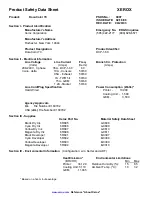
63
Outline
It is said that red eyes often occur when a person is
photographed with a flash. While the pupils dilate in a
dark place, the strobe light is reflected from the back
of the pupils and tinged with the red of the blood
capillaries. In the red eye reduction mode, the strobe
flashes more than ten times in a short period to make
the pupils contract. This reduces the light entering the
pupils, moderating the red reflections. Other than this
special flashing pattern, the operation is the same as in
the auto flash mode.
Specifications of the built-in strobe
The built-in strobe is optimally designed for
photographing a person. For instance, the surface
treatment of the luminous body disperses light. The
luminous power of the strobe is about guide number
(GN) 9. Since the camera’s sensitivity is equivalent to
ISO 100, if APERTURE is set to OPEN (the f value is
between F4 and F4.7), and the subject is 1.8 m away,
guide number 9 is sufficient because 1.8
×
4.7 = 8.46.
In other words, the built-in strobe is not powerful
enough for a subject more than 1.8 m away.
The color temperature of the light emitted from the
built-in strobe is about 7300K. Generally, it is said that
human eyes are able to distinguish between two colors
when their color temperatures have a difference of
400K. To use the built-in strobe simultaneously with
an external strobe (to irradiate the subject), some
considerations are necessary. For instance, care must
be taken to have both the built-in and external strobes
evenly irradiate the subject, or the external strobe must
be used only for assistance. It is recommended that
you use an external strobe that has as high a color
temperature as possible. When using an external
strobe, make sure to adjust WHITE BALANCE on the
camera.
1
Tips
For a subject more than 1.8 m away, set the flash mode
to
A
. In mode
A
, the shutter speed is adjusted
automatically.
What is Color Temperature?
A red light makes a white object look reddish. This
mechanism applies to photographs. When the subject
is under a reddish light, the subject looks reddish on
the picture. Color temperature is a way to represent the
colors of light as values.
When pure carbon is burnt under ideal conditions, it
produces different colors at different combustion
temperatures. A color temperature is a numeric value
that represents a color based on the color-temperature
correspondence of pure carbon combustion. With the
color temperature going from the lowest to the highest,
the color changes in the following sequence: reddish,
yellowish, neutral, and bluish. In general, the color
temperatures of natural lights are as shown below.
Sunlight at sunrise and sunset: 3500K to 5000K
Daylight: 5400K
Daylight at noon: 6000K to 6500K
Sky light: 10000K to 12000K
Shade under a clear sky: 12000K to 18000K
Strobes also vary in their color temperatures. Some
strobes are vulnerable to color temperature drops after
continued use.
To support strobes of different color temperatures, this
camera allows color temperature adjustment between
4000K and 7000K in steps of about 400K to 500K in
MANUAL mode. For instance, when the color
temperature has been set to 5600K and the
photographed picture is bluish, set the color
temperature to 6000K or higher and try again.
When AUTO is selected, the white balance is
automatically adjusted upon pre-lighting within the
range of the automatic photometry of the subject.
When automatic photometry is disabled, the color
temperature is fixed at 5600K.
Although 5500K is commonly recommended for
photography, this value is not directly related to this
camera. The 5500K recommendation is based merely
on the characteristics of films which are designed for
5500K.
Содержание UPX-DP10
Страница 267: ......
Страница 268: ...Printed in Japan Printed on recycled paper ...
















































